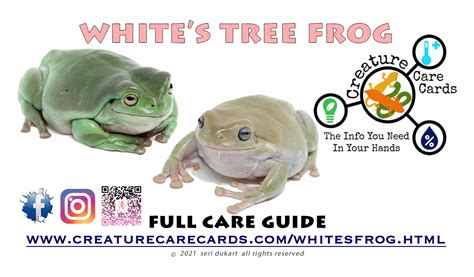Whites Tree Frog Tank Mates: A Comprehensive Compatibility Chart
The Whites Tree Frog ( Litoria caerulea) is a popular pet due to its docile nature and striking appearance. However, responsible ownership involves understanding their needs and carefully selecting suitable tank mates. Introducing incompatible species can lead to stress, injury, or even death for your frogs. This comprehensive guide provides a compatibility chart and detailed information to help you choose the best companions for your Whites Tree Frog.
Understanding Whites Tree Frog Needs Before Choosing Tank Mates
Before diving into potential tank mates, it's crucial to understand the Whites Tree Frog's requirements. They are arboreal, meaning they spend most of their time in the trees and branches. They need a spacious, humid enclosure with plenty of climbing opportunities, such as branches, vines, and plants. The temperature and humidity levels must be carefully maintained within their preferred range. Introducing a tank mate that disrupts this environment or poses a threat to the frog's safety is a recipe for disaster.
Whites Tree Frog Tank Mate Compatibility Chart
This chart outlines the compatibility of various animals with Whites Tree Frogs. Note: Compatibility is not always guaranteed, and individual animal temperaments can vary. Close monitoring is essential, and separation may be necessary if any signs of aggression or stress are observed.
| Potential Tank Mate | Compatibility | Reasons for Compatibility/Incompatibility | Considerations |
|---|---|---|---|
| Other Whites Tree Frogs (Same Sex) | Generally Good | Often coexist peacefully, especially with ample space and resources. | Ensure sufficient space, food, and hiding places to prevent competition. |
| Other Whites Tree Frogs (Opposite Sex) | Potentially Good | Can breed, leading to increased population. Requires much larger enclosure. | Prepare for a significant increase in responsibility, including breeding and tadpole care. |
| Smaller Tree Frogs (e.g., Green Tree Frogs) | Generally Poor | Size difference increases the risk of predation or stress for the smaller frog. | Avoid completely. |
| Geckos (e.g., Leopard Geckos) | Generally Poor | Different environmental needs; geckos may see frogs as prey. | Avoid completely. |
| Insects (Crickets, Dubia Roaches) | Good (Food) | Essential part of their diet. However, ensure live insects are removed after feeding to prevent issues. | Supervise feeding closely to avoid escapees and potential predation on your frog. |
| Snails | Generally Good | Help maintain a clean environment by consuming algae and waste. | Monitor snail population to avoid overgrowth. |
| Isopods (Pill Bugs) | Generally Good | Help maintain a clean environment and provide additional food source. | Ensure adequate ventilation to avoid dampness. |
Frequently Asked Questions (FAQs)
Can I keep two male Whites Tree Frogs together?
While possible, it's generally not recommended. Males can become territorial and aggressive towards each other, especially if space, food, or breeding sites are limited. It's far safer to keep males in separate enclosures.
Can I keep a Whites Tree Frog with a different species of tree frog?
This is generally not advisable. Different species have different needs regarding temperature, humidity, and even diet. There's also the risk of disease transmission and predation, especially if there's a significant size difference.
What insects are safe to feed my Whites Tree Frog?
Crickets, dubia roaches, and other appropriately sized insects are suitable. Avoid wild-caught insects due to potential pesticide exposure and parasites. Always remove uneaten insects to maintain a clean and safe environment.
How much space do I need for multiple Whites Tree Frogs?
The larger the enclosure, the better. For multiple frogs, aim for a significantly larger enclosure than you would for a single frog. Sufficient space minimizes competition for resources and reduces the risk of aggression.
What are the signs of stress or aggression in my Whites Tree Frogs?
Signs of stress include changes in appetite, lethargy, unusual vocalizations, and changes in skin coloration. Aggression may manifest as chasing, biting, or physical injury. If you observe any of these signs, immediate intervention, potentially including separation, may be necessary.
By carefully considering the compatibility chart and the FAQs provided, you can ensure a safe and harmonious environment for your Whites Tree Frog and any potential tank mates. Remember that responsible pet ownership involves ongoing observation and a willingness to adjust as needed to maintain the well-being of your animals.

